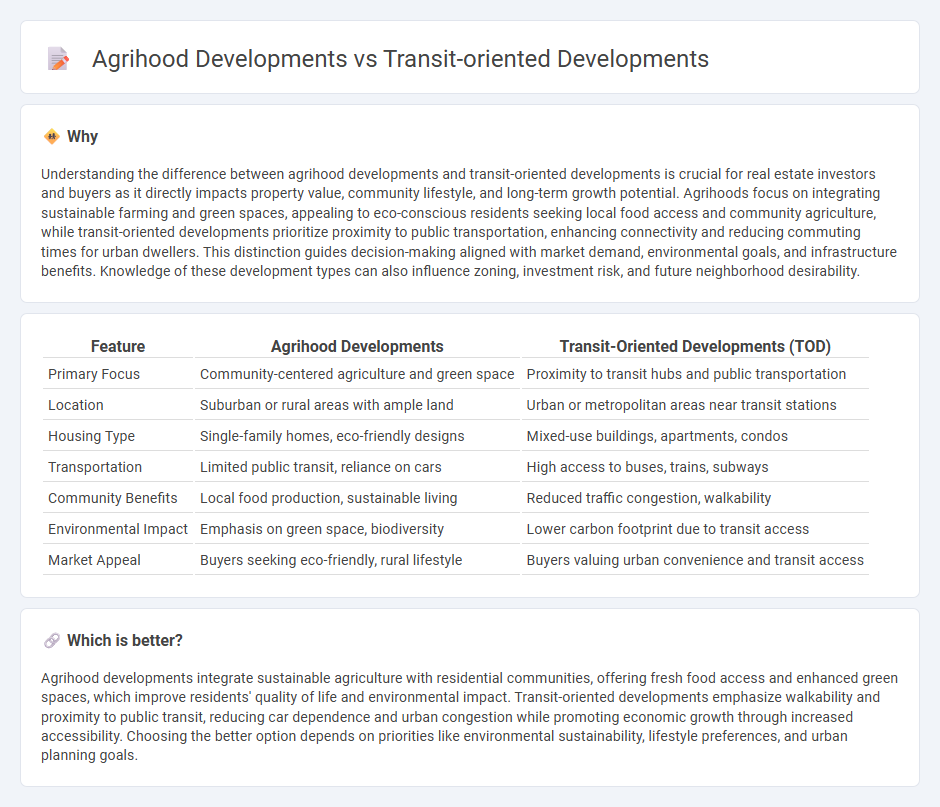
Agrihood developments integrate sustainable farming and residential living, fostering community engagement with fresh, locally grown produce, while transit-oriented developments focus on high-density housing near public transportation to reduce car dependency and enhance urban mobility. Both approaches aim to create vibrant, eco-friendly neighborhoods but prioritize different lifestyle and environmental benefits. Explore the distinct advantages and future potential of agrihoods and transit-oriented projects to understand their impact on real estate trends.
Why it is important
Understanding the difference between agrihood developments and transit-oriented developments is crucial for real estate investors and buyers as it directly impacts property value, community lifestyle, and long-term growth potential. Agrihoods focus on integrating sustainable farming and green spaces, appealing to eco-conscious residents seeking local food access and community agriculture, while transit-oriented developments prioritize proximity to public transportation, enhancing connectivity and reducing commuting times for urban dwellers. This distinction guides decision-making aligned with market demand, environmental goals, and infrastructure benefits. Knowledge of these development types can also influence zoning, investment risk, and future neighborhood desirability.
Comparison Table
| Feature | Agrihood Developments | Transit-Oriented Developments (TOD) |
|---|---|---|
| Primary Focus | Community-centered agriculture and green space | Proximity to transit hubs and public transportation |
| Location | Suburban or rural areas with ample land | Urban or metropolitan areas near transit stations |
| Housing Type | Single-family homes, eco-friendly designs | Mixed-use buildings, apartments, condos |
| Transportation | Limited public transit, reliance on cars | High access to buses, trains, subways |
| Community Benefits | Local food production, sustainable living | Reduced traffic congestion, walkability |
| Environmental Impact | Emphasis on green space, biodiversity | Lower carbon footprint due to transit access |
| Market Appeal | Buyers seeking eco-friendly, rural lifestyle | Buyers valuing urban convenience and transit access |
Which is better?
Agrihood developments integrate sustainable agriculture with residential communities, offering fresh food access and enhanced green spaces, which improve residents' quality of life and environmental impact. Transit-oriented developments emphasize walkability and proximity to public transit, reducing car dependence and urban congestion while promoting economic growth through increased accessibility. Choosing the better option depends on priorities like environmental sustainability, lifestyle preferences, and urban planning goals.
Connection
Agrihood developments integrate community-centered agriculture with residential living, promoting sustainable food systems and green spaces. Transit-oriented developments focus on creating high-density, walkable neighborhoods near public transit hubs to reduce car dependency. Both models prioritize sustainable living, enhancing community connectivity and environmental resilience by blending accessibility with eco-friendly land use.
Key Terms
**Transit-Oriented Developments:**
Transit-oriented developments (TODs) prioritize high-density, mixed-use communities centered around public transit hubs to reduce car dependency and enhance urban sustainability. These developments integrate residential, commercial, and recreational spaces within walking distance of transit stations, fostering reduced traffic congestion and lower greenhouse gas emissions. Explore more about how TODs shape future urban landscapes and promote eco-friendly living.
Mixed-Use Zoning
Transit-oriented developments (TODs) maximize mixed-use zoning by integrating residential, commercial, and recreational spaces near public transit hubs, enhancing walkability and reducing car dependency. Agrihood developments blend mixed-use zoning with urban agriculture, incorporating community farms and green spaces alongside housing and local amenities to foster sustainability and local food production. Explore how these innovative zoning strategies shape community design and sustainability goals.
Public Transit Access
Transit-oriented developments prioritize proximity to public transit hubs, enhancing accessibility and reducing reliance on private vehicles. Agrihood developments emphasize proximity to agricultural spaces but often lack integrated public transit options, limiting transit accessibility for residents. Discover how these development models impact sustainable urban mobility and community connectivity.
Source and External Links
Transforming the Urban Space Through Transit-Oriented Development - This webpage discusses transit-oriented development (TOD) as a strategy to concentrate jobs, housing, and services around public transport stations, promoting compact and mixed-use development.
Transit-oriented development - Wikipedia - This article explains transit-oriented development (TOD) as a type of urban planning that maximizes residential, business, and leisure spaces near public transport, aiming for walkable and mixed-use communities.
Transit-Oriented Development | FTA - This webpage provides an overview of TOD, highlighting its role in creating dense, walkable, and mixed-use developments near transit, which attract vibrant communities and support economic growth.
 dowidth.com
dowidth.com